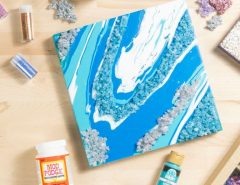Bubble or blister paint is a defect that occurs because the paint layer separates from the underlying surface or substrate. Such blisters burst over time, and if they are not repaired, the paint will peel. In this article, we present how to fix paint bubbles on wall inside and outside.
Luckily, repairing paint with bubbles or blisters is easy once the underlying cause is remedied. Find here suggestions from professionals to repair paint with bubbles or blisters because if the cause is not attacked from the beginning, the paint will continue to blunt.
How to fix paint bubbles on wall?
If the blisters reach the substrate, you must first investigate and eliminate the source of moisture. The blisters that appear on the coating are usually for simple environmental problems. So when painting the wall, there was humidity or too much heat. First, remove the bubbles or blisters by scraping them and then sanding them until the rough edges smooth and soften. If all paint needs to be removed until the substrate is exposed, apply a quality primer and allow it to dry completely. Paint again with quality latex paint for exteriors.

Repairing the bubbles or blisters in the interior paint requires a lighter touch up than outside and perhaps patching and smoothing a little, but it is easier to achieve a uniform result.
After diagnosing and addressing the cause, remove bubbles or blisters as stated above. Scrape more gently to avoid damaging the surface of the drywall that is more delicate. After sanding, you may need to smooth the repaired area by filling with putty or drywall compound. If so, make sure the patch is dry, sanded until smooth, clean and coated with primer. When the primer dries, apply a touch-up layer with quality latex paint.
Causes of paint with bubbles or blisters outdoors:
- Improper surface preparation (wet or dirty substrate)
- Application of paint on a hot surface under direct sunlight; the paint will dry too quickly and trap solvent vapors under the film
- Exposure to moisture, whether from dew, condensation or rain, too soon after painting, mainly a problem with latex paints
- Leakage of moisture through the walls, mainly a problem with oil-based and alkyd paints
- Application of oil-based or alkyd paints on primer (base) or latex paint
Most of these causes are easy to prevent by ensuring that the substrate is prepared, cleaned, and dried properly. Also, avoid painting when dew, moisture, or rain can affect a fresh coat of paint.
Inadequate ventilation may allow indoor moisture to escape through the walls. Fans should be installed in particularly damp rooms to prevent this. In extreme cases, install a vapor barrier either on the interior or exterior surface of the walls. Construction professionals who regularly face such extreme moisture problems are the ones who best diagnose such situations.
Causes of paint with bubbles or blisters indoors:
- Wet or wet surface
- Moisture absorption into the house or manufactured home through the exterior walls, mainly a problem with oil-based and alkyd paints
- Exposure of latex bases to high humidity shortly after drying the paint
- Other moisture problems behind the walls, such as small leaks of plumbing or pipes that are “sweating” or small leaks in the ceiling, siding, windows.
Also, in most of these cases, paint with bubbles or blisters is easy to avoid or fix by ensuring that the substrate is clean and dry. If you are painting on a soaked day, dry the air with fans, an air conditioner or a dehumidifier. It is necessary to eliminate any other source of moisture. Repair leaks, consider installing fans and remove and replace sealant paste lose around windows and siding.
Tags: blistering, bubbling paint, paint, repair wall




Leave a Reply
You must be logged in to post a comment.